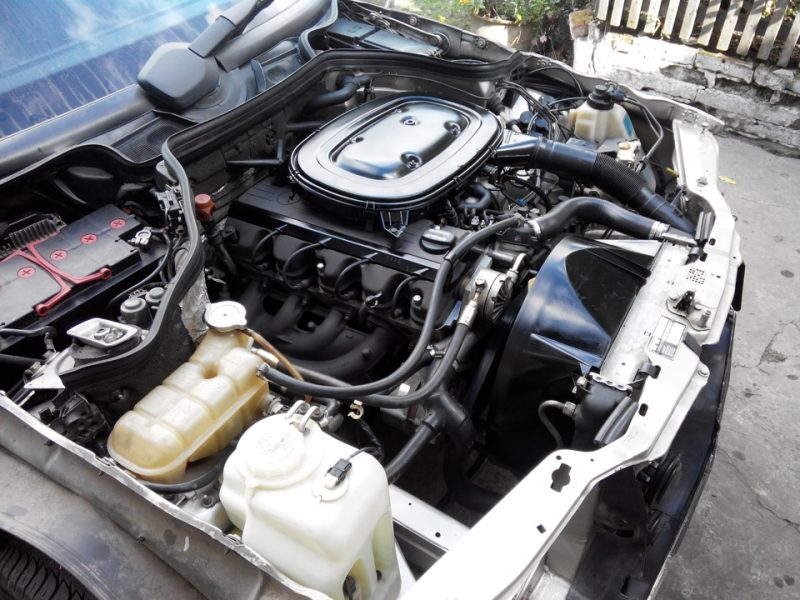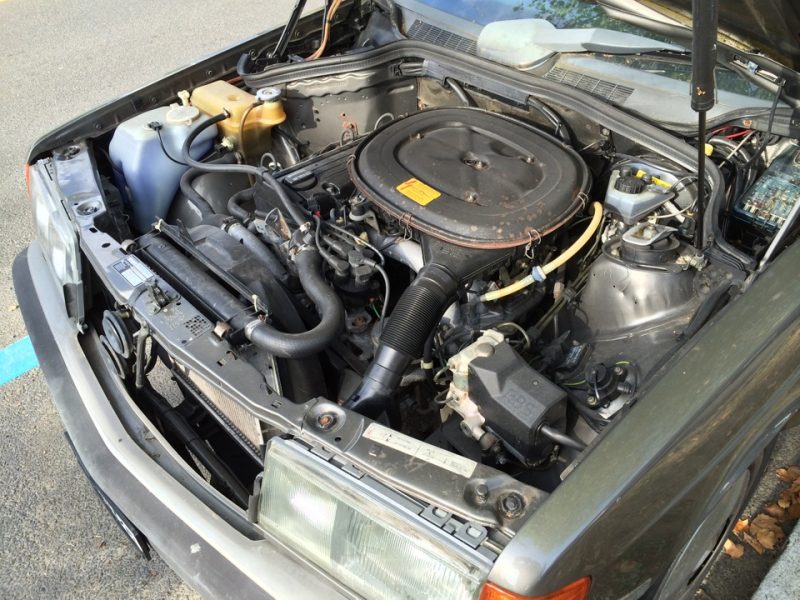Mercedes-Benz M102 E20 / V20 engine is a reliable and time-tested power unit, which was produced from 1980 to 1994. This engine was used in many Mercedes-Benz models, starting from the legendary 190 W201 and ending with utilitarian versions of the G-Class. Its main advantages were high durability, ease of maintenance and unpretentiousness in operation.
Main characteristics of the M102 2.0 engine
| Characteristics | Value |
|---|---|
| Manufacturing | Stuttgart-Untertürkheim Plant |
| Engine make | M102 |
| Years of production | 1980-1994 |
| Cylinder block material | Cast iron |
| Power system | Carburetor/Injector |
| Type | Ready |
| Number of cylinders | 4 |
| Valves per cylinder | 2 |
| Piston stroke, mm | 80.25 / 80.2 |
| Cylinder diameter, mm | 89 |
| Compression ratio | 8-9 |
| Engine displacement, cc | 1996-1997 |
| Engine power, hp / rpm | 86-122 / 5000-5500 |
| Torque, Nm/rpm | 165-178 / 2500-3500 |
| Environmental standards | Up to Euro 1 |
| Engine weight, kg | ~165 |
| Oil consumption, gr./1000 km | To 1500 |
| Oil volume in the engine, l | 4.5-5.0 |
| Oil change is carried out, km | 7000-10000 |
| Engine operating temperature, °C | ~95 |
| Engine life, thousand km | – (according to the factory data) |
| 420+ (in practice) | |
| Tuning, hp | 200+ (potential) |
| – (without loss of resource) | |
| Application | Mercedes-Benz 190 (W201) |
| Mercedes-Benz E-Class (W124) | |
| Mercedes-Benz G-Class (W460, W463) | |
| Mercedes-Benz W123 |
Design and operating features
The M102 engine is based on a cast iron cylinder block, making it resistant to wear and durability. The use of both carburetor and injector power system provided flexibility in production and adaptation to different markets. The engine’s operating temperature is around 95°C, which contributes to stable operation even under high loads.
Benefits of the M102 engine
- High service life: on average, the engine can withstand more than 420,000 kilometers without major overhaul.
- Tuning potential: with modifications the power can be increased up to 200+ hp without critical reduction of resource.
- Universality: the engine was installed on a wide range of models, including passenger cars and off-road vehicles.
Reliability, problems and repair of the engine Mercedes M102 2.0

The Mercedes-Benz M102 inline four-cylinder engine appeared in 1980 as a replacement for the obsolete M115 and was developed from scratch. In the new 102 family (which included more 1.8-liter, 2.3-liter and sporty 2.5-liter engines) was redesigned cylinder block, which is made of cast iron, crankshafts were put two types, with a stroke of 80.25 mm and 80.2 mm, respectively, working volumes of 1997 and 1996 cc. Eight-valve cylinder head with a single camshaft, as well as the cylinder block, created anew without the use of hydrocompensators valve clearances. The diameter of the intake valves is 43 mm, the exhaust valves 39 mm.
The timing drive uses a single-row chain, which was notorious for its unreliability and low service life. In 1987, the chain was replaced by a double-row chain and the service life was slightly increased. On average, the timing chain lasts 100-150 thousand kilometers.
In 1984, the M102 engine was finalized, heavy connecting rods and crankshaft gave way to new lightweight ones, there were hydrocompensators, changed engine mounts and oil filter.
Together with the in-line four, a related, partially unified, six-cylinder engine M103 was produced.
The replacement for the 102nd engine came out in 1992 and was a two-liter engine of the M111 family, which within two years was supplanted by the M102 with the same displacement.
Modifications of M102 2.0 engines
- M102.920 (1980 – 1986) – the first carbureted version with 109 hp at 5200 rpm, 170 Nm of torque at 3000 rpm. Stromberg 175 CDT carburetor, compression ratio 9. Used on Mercedes W123.
- M102.921 (1982 – 1984) – simplified version with Stromberg 175CD carburetor, other camshafts, compression ratio 9, power 90 hp at 5000 rpm, torque 165 Nm at 2500 rpm. It was used in Mercedes 190 W201.
- M102.922 (1985 – 1990) – a refined version of the M102.920 with lightweight connecting rods, crankshaft and other things described above, Stromberg 175 CDT carburetor. The version is adapted for Mercedes W124. Compression ratio 9, power 109 hp at 5500 rpm, torque 170 Nm at 3000 rpm. Since 1986, the carburetor was replaced by Pierburg 2 E-E. It was used on Mercedes W124.
- M102.924 (1984 – 1991) – modified version of M102.921 with light connecting rods, crankshaft and other things described above, carburetor up to 1986 was Stromberg 175 CDT, further Pierburg 2 E-E Version adapted for Mercedes W124. Compression ratio 9, power 109 hp at 5500 rpm, torque 170 Nm at 3000 rpm. Since 1986, the carburetor was replaced by Pierburg 2 EE. It was used on Mercedes 190 W201.
- M102.938 (1982 – 1984) – analog of M102.921, compression ratio was reduced to 8, power dropped to 86 hp. It was used in Mercedes 190 W201.
- M102.939 (1980 – 1985) – analog of M102.920, compression ratio reduced to 8, power dropped to 101 hp. It was put on Mercedes W123.
- M102.962 (1982 – 1993) – analog of M102.921 with Bosch KE-Jetronic injection, compression ratio 9, power dropped to 122 hp at 5500 rpm, torque 178 Nm at 3500 rpm, for version with catalytic converter power 118 hp, torque 172 Nm. The motor was used in Mercedes 190 W201.
- M102.963 (1985 – 1992) – analog of the above model for use in Mercedes W124.
- M102.964 (1986 – 1991) – analog of the above model for use in the Mercedes Gelandewagen W460.
- M102.965 (1990 – 1994) – analog of the above model with a crankshaft stroke of 80.2 mm (was 80.25 mm), working volume of 1996 cm³. The engine was put in Mercedes Gelandewagen W463.
Problems and disadvantages of Mercedes M102 engines

- Camshaft wear. The camshaft lives about 100-150 thousand kilometers, the issue is solved only by replacement.
- High oil consumption. Oil consumption on the M102 is caused by the wear of oil caps, which go about 100 thousand kilometers. Replacing the caps will reduce consumption.
- Engine vibrations. A common problem for the 102 engine, caused by the wear of the cushions and is solved by their replacement.
In addition, for this engine is characterized by knocking at idle speeds and it is considered quite normal. Generally speaking, the age of the engine Mercedes M102 is such that anything can happen and when anything can happen, all these engines have long ago rolled out their motor-resource, and if you add to this mass of non-original spare parts that have managed to put there for years of operation and constantly poured cheap working fluids, then no reliability to expect from this motor is not worth it. Buying M102 engine you should be ready for everything, it is better to buy a fresher Mercedes engine.
Mercedes M102 engine tuning
Compressor
It is worth starting with the fact that the very idea of tuning a thirty-year-old motor is not too reasonable because of its high cost, low potential, outdated design, lack of reliability and so on. It will be much more logical to repair it and drive while it drives, or buy another Mercedes-Benz engine, M111 for example. In case you really want to add some horses to the 102, then you should reject the option of boring under the piston 95.5 mm (2.3 liters), the maximum is tochitsya up to 2.2 liters and in this case you need to look for pistons from a third-party manufacturer, respectively, you must also grind the channels of the cylinder-head, so options to increase the working volume is better to forget. Sport shafts on the old eight-valve? Not the best idea.
There are two working options:
- Put a compressor (Eaton M45 for example, or inexpensive AutoTurbo RK-23), intercooler, injectors from 16-valve M102 E23/2 or other more productive, adjust on Janvar and it will give a gain of 30-50 hp
- Buy a contract engine Mercedes M111 Compressor, weld it and do not create unnecessary difficulties.
MERCEDES MOTOR RATING: 3
